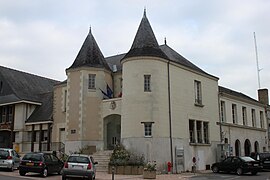Doué-la-Fontaine
Doué-la-Fontaine | |
|---|---|
Part of Doué-en-Anjou | |
 The town hall of Doué-la-Fontaine | |
Doué-la-Fontaine | |
| Commune | Doué-en-Anjou |
| Area 1 | 35.9 km2 (13.9 sq mi) |
| Population (2019)[1] | 7,608 |
| • Density | 210/km2 (550/sq mi) |
| Time zone | UTC+01:00 (CET) |
| • Summer (DST) | UTC+02:00 (CEST) |
| Postal code | 49700 |
| Elevation | 48–105 m (157–344 ft) (avg. 76 m or 249 ft) |
| 1 French Land Register data, which excludes lakes, ponds, glaciers > 1 km2 (0.386 sq mi or 247 acres) and river estuaries. | |
Doué-la-Fontaine (French pronunciation: [dwe la fɔ̃tɛn] ⓘ) is a former commune in the Maine-et-Loire department in western France.[2] On 30 December 2016, it was merged into the new commune Doué-en-Anjou.[3] It is located in the heart of Anjou, a few kilometres from the great châteaux of the Loire Valley.
Sights
The town was known as Vetus Doadum ("Old Doadum"), Teotuadum castrum,
Doué-la-Fontaine is the site of the oldest habitable donjon (keep) in France, dating back to c. 950. No traces of Doué's medieval fortifications remain, save the names of "gates" given to certain streets. The castle is widely believed to have been the first European castle to be built out of stone (at around 950).
Nearby are the troglodyte dwellings, where the inhabitants took refuge from the Normans, and commercial mushroom-growing caves. The stone of Doué-la-Fontaine was quarried for sarcophagi 4 km (2.5 mi) from the town. The zoo of Doué-la-Fontaine is partly built within the network of the troglodytes sites and dwellings. Recently, a cave containing sarcophagi was unearthed.
In 1793, Doué-la-Fontaine was the site of massacres during the counter-Revolutionary Revolt in the Vendée, suppressed by General Santerre.
Events
Doué-la-Fontaine is known as the rose capital of France. A "Festival of the Rose" is held there in July of each year, where in one park alone more than 800 varieties can be seen.
Notable people
- Anthony Réveillère, football player for Olympique Lyonnais.
See also
References
- ^ Téléchargement du fichier d'ensemble des populations légales en 2019, INSEE
- ^ Des villages de Cassini aux communes d'aujourd'hui: Commune data sheet Doué-la-Fontaine, EHESS (in French).
- ^ Arrêté préfectoral 23 September 2016 (in French)
- ^ Hofmann, Johann Jacob (1698). "Andes". Lexicon Universale.
{{cite book}}:|website=ignored (help).
External links
- History of the village and a collection of photos including a Carolingian residence and an ancient stone amphitheatre. (in English)
- History of Doué-la-Fontaine (in French)
- Fact sheet (in French)
- Bioparc: zoo de Doué-la-Fontaine

